The Network Fault Monitoring Tools Market is estimated to be valued at USD 2.5 billion in 2025 and is projected to reach USD 4.3 billion by 2035, registering a compound annual growth rate (CAGR) of 5.5% over the forecast period.
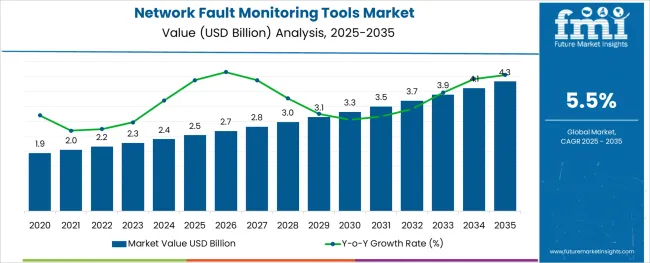
The network fault monitoring tools market is experiencing steady expansion as organizations prioritize uptime, performance transparency, and service continuity in increasingly hybrid and multi-cloud environments. The rising incidence of network disruptions, coupled with the proliferation of connected devices and distributed workforces, has intensified demand for solutions that enable rapid fault detection, root cause analysis, and automated remediation.
Enterprises are adopting advanced monitoring platforms integrated with AI and machine learning to support predictive maintenance and reduce mean time to resolution (MTTR). The push for compliance with cybersecurity and SLA requirements is also reinforcing tool adoption across regulated industries.
Additionally, the growing trend of network transformation initiatives, including SD-WAN deployments and edge computing, is creating opportunities for tool providers offering scalable, modular, and interoperable fault monitoring systems. Future growth is likely to be propelled by the convergence of network management, observability, and AIOps capabilities, further embedding fault monitoring solutions into broader IT operations workflows.
The market is segmented by Deployment Type and Enterprise Size and region. By Deployment Type, the market is divided into On-Premise Network Fault Monitoring Tools and Hosted Network Fault Monitoring Tools. In terms of Enterprise Size, the market is classified into Network Fault Management Tools for Large Enterprises, Network Fault Management Tools for Small Enterprises, and Network Fault Management Tools for Medium Enterprises. Regionally, the market is classified into North America, Latin America, Western Europe, Eastern Europe, Balkan & Baltic Countries, Russia & Belarus, Central Asia, East Asia, South Asia & Pacific, and the Middle East & Africa.
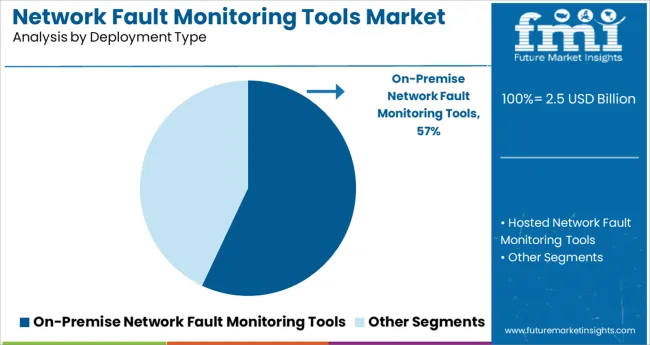
On-premise network fault monitoring tools are projected to account for 57.0% of the total market revenue in 2025, making it the leading deployment segment. This leadership is being reinforced by the preference for data sovereignty, direct infrastructure control, and enhanced security among large-scale enterprises and critical infrastructure operators.
On-premise solutions offer reduced latency in fault detection and resolution processes and provide deeper customization for integrating with proprietary systems. Organizations operating in highly regulated sectors, including finance, defense, and healthcare, continue to favor on-premise deployments due to compliance with internal data governance policies.
The ability to operate independently of internet connectivity and cloud service outages further supports this segment's demand. Moreover, long-standing IT investments and concerns about vendor lock-in have sustained the relevance of on-premise network monitoring platforms, particularly in scenarios requiring high availability, confidentiality, and internal process alignment.
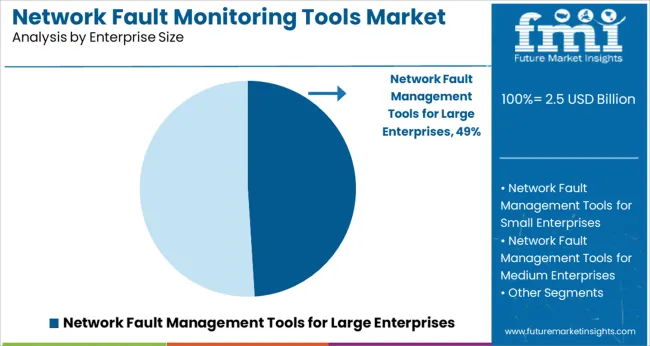
Network fault management tools for large enterprises are projected to contribute 49.0% of the total market revenue in 2025, positioning this segment at the forefront of adoption. The complexity and scale of network infrastructures in large enterprises demand advanced fault monitoring capabilities to manage multi-site, hybrid, and multi-vendor environments effectively.
These organizations often require real-time analytics, intelligent alerting, and customizable dashboards to monitor network performance across geographies and departments. The need to ensure business continuity, uphold customer SLAs, and support mission-critical applications has intensified the deployment of robust monitoring tools tailored to enterprise-grade use cases. Additionally, large enterprises have greater financial and technical capacity to integrate these tools with existing ITSM, NOC, and AIOps frameworks, further extending their operational value.
As digital transformation accelerates across sectors, the role of proactive fault detection and analytics in mitigating downtime is expected to cement large enterprises as the primary users of comprehensive network fault management solutions.
There has recently been an increase in the supply of network services among the community, who expect superior services. The increasing relevance of minimizing the negative effects of faults, the increasing reliance on software-based security solutions that address various compliance and efficient policies, and the surge of interest in paperless administrative operations across multiple organizations are the major factors driving the profitability growth of the global network fault monitoring tools market.
The life of hardware where network outage monitoring tools are implemented is shortened due to the large amount of strain caused by network and disc I/O activities. Because of the aforementioned factors, it is complicated to choose the ideal network fault monitoring tool, which has a negative influence on the global network fault monitoring tool market.
The Asia Pacific is predicted to be the fastest-growing network fault monitoring tools sector in terms of revenue, due to increased security protocols and efficiency across numerous industries including manufacturing, hospitality, information technology, and education.
The region has a large consumer base for managed network services due to its high inhabitants, growing economies, and increasing use of mobile and internet. With the escalating use of smart devices and the internet, it has become essential for the general public to have access to dependable and secure connections. This is what propels market growth in this region.
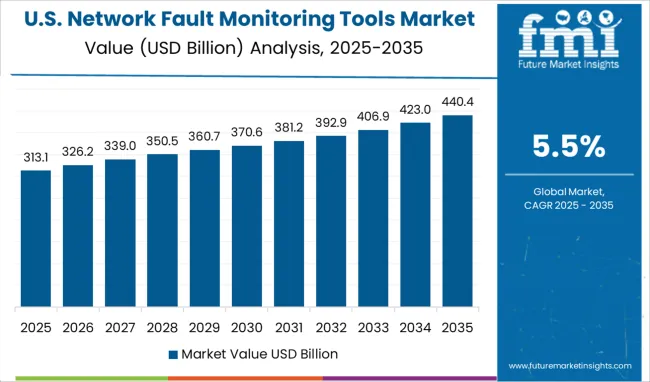
During the assessment period, the North American network services market is expected to expand at a rapid pace. North America is expected to continue at its current growth rate during the forecast period. Furthermore, North America is expected to dominate the regional market for network security software solutions, with a CAGR of 5%. As a result, these factors are expected to drive the demand for network fault monitoring tools in North America in the decades ahead.
Furthermore, the high rate of adoption among enterprises based in this region, as well as the presence of many large players with research and innovation centers in this region, are driving market expansion in North America. North America is accounting for a market share of 37% of the global network fault monitoring tools market.
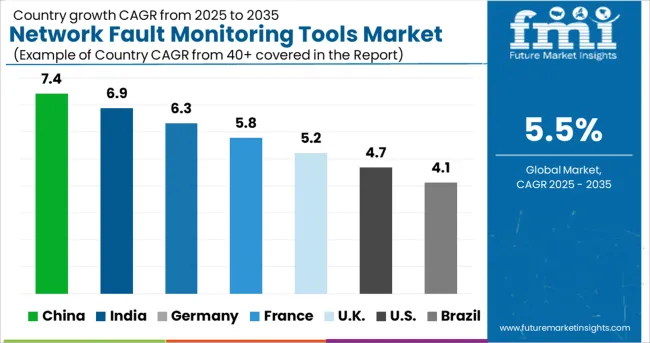
Germany is expected to dominate regional market growth. Enhanced cloud computing technologies compel the expansion of the European market for managed network services. Due to the rapid rate of deployment among enterprises premised in this region and many big players having their research and advancement centers in this region, Europe has the largest market share for network fault monitoring tools.
Furthermore, the increasing dependence on software-based security solutions in a wide range of countries, including France, is driving up market demand for network fault monitoring tools in Europe. Europe holds 22.3% of the global network fault monitoring tools market.
Small enterprises, despite their size, play a significant role in the economy. They outnumber large corporations, employ a large number of people, and are generally entrepreneurial in nature, aiding in the shaping of innovation.
Over the forecast period, demand for small and medium-sized enterprise segments is expected to witness significant demand.
Manufacturers are adopting various marketing strategies such as new product launches, geographical expansion, mergers and acquisitions, partnerships, and collaboration to identify the interest of potential buyers and create a larger customer base. For instance,

Some of the leading Network Fault Monitoring Tools manufacturers include AppNeta, Viavi Solutions Inc., Cisco Systems, Inc., NetScout, ExtraHop Networks, Riverbed Technology, SevOne, LiveAction, HP Enterprises, SolarWinds Worldwide, LLC., and CA Technologies.
These key network fault monitoring tool providers are adopting various strategies such as new product launches and approvals, partnerships, collaborations, acquisitions, mergers, etc. to increase their sales and gain a competitive edge in the global network fault monitoring tools market. For instance,
| Report Attribute | Details |
|---|---|
| Growth Rate | CAGR of 5.5% from 2025 to 2035 |
| Market Value in 2025 | USD 2,157.34 Million |
| Market Value in 2035 | USD 3,673.0 Million |
| Base Year for Estimates | 2024 |
| Historical Data | 2020 to 2024 |
| Forecast Period | 2025 to 2035 |
| Quantitative Units | Revenue in USD Million and CAGR from 2025 to 2035 |
| Report Coverage | Revenue Forecast, Company Ranking, Competitive Landscape, Growth Factors, Trends, and Pricing Analysis |
| Segments Covered | Deployment, Size of Enterprise, Region |
| Regions Covered | North America; Latin America; Europe; Asia Pacific; Middle East and Africa |
| Key Countries Profiled | The USA, Canada, Brazil, Mexico, Germany, The United Kingdom, France, Spain, Italy, China, Japan, South Korea, Singapore, Thailand, Indonesia, Australia, New Zealand, GCC, South Africa, Israel |
| Key Companies Profiled | AppNeta; Viavi Solutions Inc.; Cisco Systems, Inc.; NetScout; ExtraHop Networks,; Riverbed Technology; SevOne; LiveAction; HP Enterprises; SolarWinds Worldwide LLC; CA Technologies |
| Report Customization & Pricing | Available upon Request |
The global network fault monitoring tools market is estimated to be valued at USD 2.5 billion in 2025.
It is projected to reach USD 4.3 billion by 2035.
The market is expected to grow at a 5.5% CAGR between 2025 and 2035.
The key product types are on-premise network fault monitoring tools and hosted network fault monitoring tools.
network fault management tools for large enterprises segment is expected to dominate with a 49.0% industry share in 2025.






Our Research Products

The "Full Research Suite" delivers actionable market intel, deep dives on markets or technologies, so clients act faster, cut risk, and unlock growth.

The Leaderboard benchmarks and ranks top vendors, classifying them as Established Leaders, Leading Challengers, or Disruptors & Challengers.

Locates where complements amplify value and substitutes erode it, forecasting net impact by horizon

We deliver granular, decision-grade intel: market sizing, 5-year forecasts, pricing, adoption, usage, revenue, and operational KPIs—plus competitor tracking, regulation, and value chains—across 60 countries broadly.

Spot the shifts before they hit your P&L. We track inflection points, adoption curves, pricing moves, and ecosystem plays to show where demand is heading, why it is changing, and what to do next across high-growth markets and disruptive tech

Real-time reads of user behavior. We track shifting priorities, perceptions of today’s and next-gen services, and provider experience, then pace how fast tech moves from trial to adoption, blending buyer, consumer, and channel inputs with social signals (#WhySwitch, #UX).

Partner with our analyst team to build a custom report designed around your business priorities. From analysing market trends to assessing competitors or crafting bespoke datasets, we tailor insights to your needs.
Supplier Intelligence
Discovery & Profiling
Capacity & Footprint
Performance & Risk
Compliance & Governance
Commercial Readiness
Who Supplies Whom
Scorecards & Shortlists
Playbooks & Docs
Category Intelligence
Definition & Scope
Demand & Use Cases
Cost Drivers
Market Structure
Supply Chain Map
Trade & Policy
Operating Norms
Deliverables
Buyer Intelligence
Account Basics
Spend & Scope
Procurement Model
Vendor Requirements
Terms & Policies
Entry Strategy
Pain Points & Triggers
Outputs
Pricing Analysis
Benchmarks
Trends
Should-Cost
Indexation
Landed Cost
Commercial Terms
Deliverables
Brand Analysis
Positioning & Value Prop
Share & Presence
Customer Evidence
Go-to-Market
Digital & Reputation
Compliance & Trust
KPIs & Gaps
Outputs
Full Research Suite comprises of:
Market outlook & trends analysis
Interviews & case studies
Strategic recommendations
Vendor profiles & capabilities analysis
5-year forecasts
8 regions and 60+ country-level data splits
Market segment data splits
12 months of continuous data updates
DELIVERED AS:
PDF EXCEL ONLINE
Network Simulator Software Market Size and Share Forecast Outlook 2025 to 2035
Network Connectivity Tester Market Size and Share Forecast Outlook 2025 to 2035
Network Analyzers Market Size and Share Forecast Outlook 2025 to 2035
Network as a Service (NaaS) Market Size and Share Forecast Outlook 2025 to 2035
Network Analytics Market Size and Share Forecast Outlook 2025 to 2035
Network Devices Market Size and Share Forecast Outlook 2025 to 2035
Network Sandboxing Market Size and Share Forecast Outlook 2025 to 2035
Network Access Control (NAC) Market Size and Share Forecast Outlook 2025 to 2035
Network Encryption Market Size and Share Forecast Outlook 2025 to 2035
Network Packet Broker Market Size and Share Forecast Outlook 2025 to 2035
Network Traffic Analytics Market Size and Share Forecast Outlook 2025 to 2035
Network Function Virtualization (NFV) Market Size and Share Forecast Outlook 2025 to 2035
Network Cable Tester Market Size and Share Forecast Outlook 2025 to 2035
Network Point-of-Care Glucose Testing Market Size and Share Forecast Outlook 2025 to 2035
Network Forensics Market Size and Share Forecast Outlook 2025 to 2035
Network Telemetry Market Size and Share Forecast Outlook 2025 to 2035
Network Security Policy Management Market Size and Share Forecast Outlook 2025 to 2035
Network Probe Market Size and Share Forecast Outlook 2025 to 2035
Network Traffic Analysis Solutions Market Size and Share Forecast Outlook 2025 to 2035
Network Slicing Market Size and Share Forecast Outlook 2025 to 2035

Thank you!
You will receive an email from our Business Development Manager. Please be sure to check your SPAM/JUNK folder too.
Chat With
MaRIA